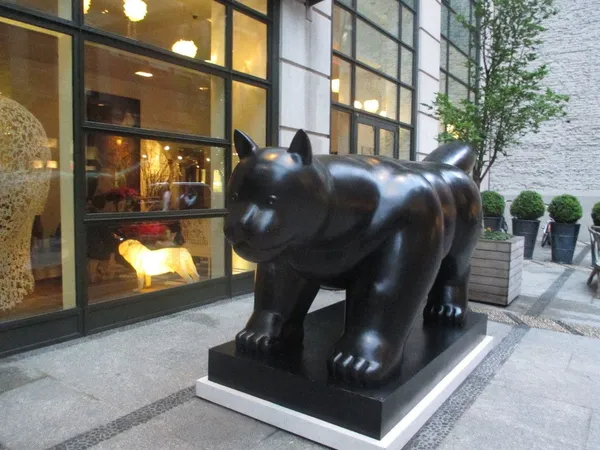 |
| Cate Blanchett and Julian Rosefeldt talk Manifesto animals and more inside the Crosby Street Hotel Photo: Anne-Katrin Titze |
Through the words of Yvonne Rainer, Louis Aragon, Olga Rozanova, Guy Debord, Lars von Trier, Stan Brakhage, Werner Herzog, Jim Jarmusch, Thomas Vinterberg, Tristan Tzara, Paul Éluard, Claes Oldenburg, Sol LeWitt, Barnett Newman, Kurt Schwitters, Francis Picabia, André Breton, Antonio Sant'Elia, Lebbeus Woods and others in Julian Rosefeldt's film Manifesto, a chameleonic Cate Blanchett in 14 roles, speaks lines of truth and dare to us giving them all new context in contemporary situations.
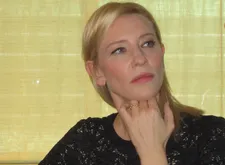 |
| Cate Blanchett: "Julian and I were both in New York and we sat down and he had come up with sort of about fifty characters, about fifty, sixty different scenarios." Photo: Anne-Katrin Titze |
The role of the Manifesto animals as being "another way of portraying humanity", how the changing of the settings each day "was a bit like Alice in Wonderland", the importance of finding "points of intersection", and having the characters evolve "organically" were revealed inside the Crosby Street Hotel before Cate and Julian had to rush off to walk the red carpet for their Tribeca Film Festival première at the Festival Hub in Spring Studios.
Anne-Katrin Titze: How did you decide on the accents to go with each Manifesto cluster and with the visuals? As the third part, really, in the decision making?
Julian Rosefeldt: Will you answer that?
Cate Blanchett: It was very night-before, random. There was, because we had to shoot so quickly, an incredible amount of preparation that went into the planning of the work. You know, there was one point where Julian and I were both in New York and we sat down and he had come up with sort of about fifty characters, about fifty, sixty different scenarios. And then seeing which ones would both align and which manifestos lend themselves more to conversation, to monologue, or to an inner monologue.
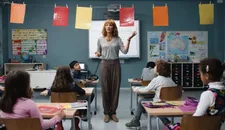 |
| Julian Rosefeldt: "Sometimes it was kind of natural. The teacher seemed to be. We both have children - not together." |
And then, once we’d found those points of intersection between those three elements, then it was like, okay, what about we … because obviously they all had to be in English because I can’t speak Mandarin, unfortunately. And that might cross a boundary, a culturally sensitive boundary, anyway. And then it was just, okay, why don’t we make this one from here? Why don’t we make this one from there?
JR: Sometimes it was kind of natural. The teacher seemed to be. We both have children - not together. It seemed to me like a person that we could create quite close to Cate herself - like, she’s Australian. And then the stock exchange, of course, happens on Wall Street. And the funeral, why not select a light Canadian accent? Or the homeless man in a Newcastle one?
So it kind of evolved organically. Although we gave up on many beautiful ideas for scenes. But when I’m asked, “Can you tell us about the scenes that you didn’t realize?” I have a hard time of remembering them all. Because once you start doing something, you live with what you have.
 |
| Cate Blanchett: "So you tried to get to a point of neutrality from which you could go in any different direction." |
I remember us bargaining, like, I wanted to do at least ten, so I asked Cate to do 20. And she said “Could we do maybe seven or eight?” Then we ended up doing twelve. It sounds very pragmatic, but this is also a part of filmmaking - that you have to make it happen. And you have to deal with time and money and children.
CB: But I was frustrated. You know, as an actor, there was an exercise we did at drama school where you tried to … You did Neutral Mask. So you tried to get to a point of neutrality from which you could go in any different direction. So that you don’t impose your own energy, you don’t impose your own way of thinking, your certain approaches upon a character so that the character can be a thing separate from you.
Obviously though you are the instrument that you’re using. And I was very frustrated, you know, because the inner voice and the connected tissue that’s really clear in the linear version is: This is my voice. This is my natural accent and I found that very frustrating. It’s almost like I wanted to make it more neutral. You know, unfortunately, you can never truly eradicate yourself.
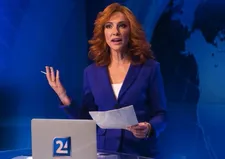 |
| Julian Rosefeldt: "And then we started to talk about the text while she became a newsreader." |
JR: It was a beautiful trip and we had a lot of fun, although [there was] all this pressure of time and circumstances. I remember meeting her every morning in the makeup wagon with a completely new character and accent. She was of course already rehearsing the accent.
And then we started to talk about the text while she became a newsreader. We had six or seven pairs of different teeth in the film. The settings were very different, of course, every day. It was a bit like Alice in Wonderland. From day to day you encountered different worlds.
AKT: Quick question about the animals - You already put a lot on your plate and then decided to add ravens…
CB: A baboon!
AKT: Exactly! A monkey, dogs, three dogs at the funeral. Why the animals?
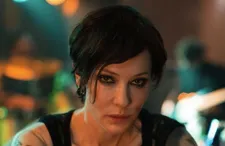 |
| Julian Rosefeldt: "I remember meeting her every morning in the makeup wagon with a completely new character and accent." |
JR: The animals are just another way of portraying humanity, I would say. They’re just a different species. If you see them altogether over the film, it’s just us, over there. I like them because they are a mirror to us in a way. Because they can’t know what’s going on in the world but they are there all the time, faithful and testimony of what we’re doing here in this world. So they are testimonies. They’re just there.
Julian Rosefeldt's 13 monitor Manifesto installation at the Park Avenue Armory was on view from December 7, 2016 through January 8, 2017.
Manifesto opens in the US on May 10.
The 16th edition of the Tribeca Film Festival presented by AT&T runs through April 30.





















